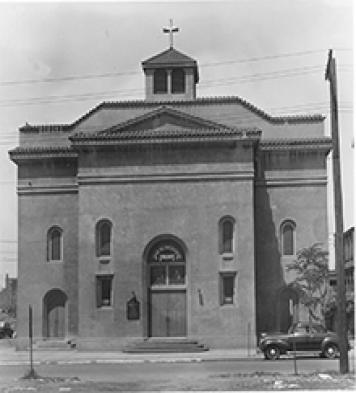William Costello, 1805–1855
|
William Costello was born in Ireland about 1805 and arrived in New York City on 14 May 1832, traveling from London on the James & Henry Cuming. He filed a declaration of intent to naturalize in New York City on 5 November 1832. William and his wife, Bridget, also born in Ireland, may have married in New York City, where their first three children were born: James in 1833, Margaret in 1835, and William Jr. in 1837. The next three children were born in Baltimore, Maryland: Catherine, or Katie, on 9 January 1842, Mary in 1843, and Thomas in 1848. The youngest, John, was born in 1849 in Pittsburgh, Pennsylvania, where the family appears in the 1850 U.S. census for the first time, with William’s occupation listed as laborer. The path of their journey, reflected in the birthplaces of their children, points to a determination to go west: Baltimore through the Cumberland Gap to the Ohio River at Pittsburgh to St. Louis, where the family arrived by 1855. They were not alone. According to Frederick A. Hodes: “Between 1835 and 1850, the town of St. Louis grew from 8,316 people to a city of 77,860 residents. A flood of European immigrants from Germany and Ireland arrived in the 1840s and 1850s. In 1850, there were 493 steamboat arrivals in St Louis from the Ohio River.” The family appears in the 1860 U.S. census in St. Louis. But, William is not among them. He had died on 16 July 1855 in St. Louis at Biddle near Sixth, in the heart of the Irish slum called the Kerry Patch. If there was a funeral, it was probably held at St. Patrick’s Church, also at Sixth and Biddle, which was considered the Irish mother church of the Catholic Archdiocese. Tragically, William Jr. died later the same year, on 24 September 1855, at the age of eighteen. He and his father may both have died of cholera. They were buried in Rock Spring Cemetery, which was established in 1849 and soon filled with victims of the cholera outbreaks of 1849, 1854, and 1866. The cemetery closed after the cholera outbreaks prompted city officials to require that cemeteries be moved outside the city limits. By the early twentieth century, most of the graves, including presumably, the graves of William Costello and his son, had been moved to Calvary Cemetery, or to a vault beneath the now closed St. Bridget of Erin Catholic Church in St. Louis City. Forgotten graves are still occasionally found at the former cemetery site as happened in June of 2014, when remains were discovered “during excavation near [the] St. Louis Ikea site,” according to a St. Louis Post Dispatch article. (Source: Joel Currier, “Tomb is found during excavation near St. Louis Ikea site,” St. Louis Post Dispatch, June 4, 2014). (Source: Frederick A. Hodes, Ph.D. 2009. Rising on the River: St. Louis 1822 to 1850, Explosive Growth from Town to City. [Tooele, Utah: The Patrice Press]) Written by Peg Simons, Ph.D. © 2017, St. Louis Genealogical Society |
 St. Patrick Church, 6th and Biddle, St. Louis Photo in the collection of the St. Louis Catholic Archdiocese Archives Used with permission |
Return to St. Louis City/County Biographies.
Last Modified: 26-Oct-2018 19:46